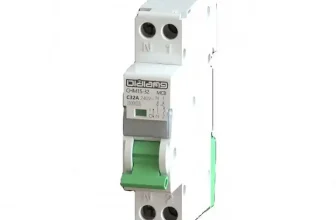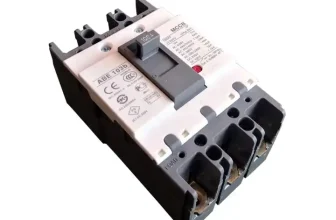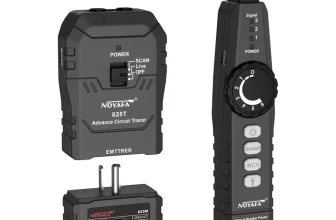A Ground Fault Circuit Interrupter (GFCI), also commonly referred to
as GFI, is a type of circuit breaker with integral capabilities to
safeguard humans against electrical shocks. This protective device
functions by detecting the imbalance of electrical current flowing into
and out of a circuit — an indication of a possible ground fault. When
such an abnormality is observed, the GFCI breaker quickly cuts off power
supply to that specific circuit, thus minimizing the risk of severe
electric shocks. Since electrical safety is paramount in all
residential, commercial, and industrial settings, understanding the role
and workings of GFCI breakers is crucial.
Importance of
understanding GFCI Breakers
Understanding Ground Fault Circuit Interrupter (GFCI) or Ground Fault
Interrupter (GFI) breakers is crucial for both homeowners and
professionals alike. This is because these types of breakers play a
pivotal role in ensuring the safety of electrical systems in
residential, commercial, and industrial settings. Their function is
paramount for preventing damage from electrical faults and protecting
individuals from deadly electrical shocks. By gaining a better
understanding of GFCI breakers, you can ensure a safer living or working
environment and also develop the ability to identify and troubleshoot
potential electrical problems.
Understanding Breakers
Brief history of breakers
Circuit breakers have been an essential component of electrical
systems for more than a century. The first rudimentary designs were
introduced in the mid-19th century as a safety mechanism to prevent
fires that could occur due to overload in the early telegraph lines. As
electrical technology advanced and became more widespread, so too did
the need for more robust and refined breakers.
The first modern circuit breaker was developed and patented by Thomas
Edison in 1879 as part of his electrical supply system. Edison’s design
was simply a switch that would turn off in the event of excessive
electrical flow, yet this basic concept laid the groundwork for future
innovations.
During the 20th century, significant improvements were made in
breaker design and technology. This era saw the introduction of
thermal-magnetic breakers, which combined heat-sensitive and magnetic
elements to interrupt the circuit when an overload occurred.
With the advent of solid-state electronics in the late 20th century,
circuit breakers became even more sophisticated. These modern breakers
utilize electronic components to quickly and accurately respond to
electrical faults, greatly improving safety and reliability.
In summary, from their humble beginnings in the mid-19th century to
their current advanced design, circuit breakers have continually
evolved, reflecting the progress and growth of electrical technology
itself. They remain a fundamental safety measure to this day, ensuring
that electrical systems function correctly and safely.
Importance
and role of breakers in electrical systems
Breakers play an indispensable role in our electrical systems, acting
as the critical line of defense against electrical faults. They are
engineered to interrupt electrical flow in the event of an overload or a
short circuit, thereby preventing electrical fires and other types of
damage.
Inherently serving as automatic safety switches, they continuously
monitor the amount of electrical current passing through them. If for
any reason, the current exceeds a breaker’s rating, it ‘trips’ or cuts
off the circuit from the power source. This momentarily unplugs all the
devices, appliances, or equipment connected to that specific circuit,
preventing them from drawing more power, which could potentially trigger
an electrical fire.
Moreover, the breakers give us the convenience of isolating a certain
part of the electrical system without needing to switch off power for
the entire building or house. They act like gatekeepers that ensure the
safe distribution of electricity throughout our homes and workplaces,
thereby protecting us against electrical hazards, and ultimately,
ensuring a safer environment.
What is a GFCI (GFI) Breaker
Detailed explanation of
GFCI Breaker
A Ground Fault Circuit Interrupter (GFCI) breaker, sometimes referred
to as Ground Fault Interrupter (GFI), is a type of circuit breaker that
immediately shuts off electrical power when it senses an imbalance
between outgoing and incoming current. This unique feature aids the GFCI
breaker in protecting against electrical shock caused by ground
faults—instances when electricity escapes the established route of its
wiring system.
The GFCI breaker is designed with a built-in sensor that constantly
monitors the flow of electricity through a circuit. The sensor compares
the amount of current flowing to the electrical device against the
current returning to the circuit. In a properly functioning circuit,
these two currents would be identical. However, if the sensor detects a
lack of balance, indicating a loss of current or ‘ground fault,’ it
interprets this as a risk of electrical shock. The GFCI breaker would
then react within a split second, cutting off the power to the circuit
and preventing potential accidents.
GFCI breakers are particularly sensitive; they are designed to
respond to even slight variances in current, ones as small as 4 or 5
milliamps. This quick, delicate response affords excellent protection
against harmful electrical shocks, which makes the GFCI breaker a vital
component in electrical safety.
In summary, a GFCI breaker monitors the electrical current in a
circuit, protecting us from potential electric shocks by swiftly cutting
off the power when it senses any sort of ground fault. This makes it
very different from regular circuit breakers that only interrupt the
circuit when the total current is high enough to cause overheating.
Why is it called GFI
The term GFI is an acronym that stands for Ground Fault Interrupter.
It’s another name for GFCI, which stands for Ground Fault Circuit
Interrupter. Both terms refer to the same device, and the names are
often used interchangeably. The name GFI or GFCI provides a clue about
what this device does. It essentially interrupts, or stops, the circuit
when it detects a ground fault, which is essentially an unintentional
electrical path between a source of current and a grounded surface. This
immediate interruption helps to prevent serious hazards that could lead
to electrical shocks or fires. Hence, the name Ground Fault Interrupter
aptly describes its vital function in ensuring electrical safety.
Working of a GFCI Breaker
Explanation of the
internal mechanism
A Ground Fault Circuit Interrupter (GFCI) breaker, widely known as a
GFI breaker, operates based on the monitoring of electrical currents
flowing through a circuit. Inside the casing of the GFCI breaker, there
is a magnetic coil responsible for detecting any imbalances in the
electrical currents.
Under normal circumstances, the electrical current running towards
the device is the same as the current returning from it. However, when
there is a ground fault, or a leakage of electricity, these currents get
imbalanced. This is where the GFCI breaker comes into play.
The GFCI breaker constantly monitors the balance between the current
flowing ‘into’ an appliance (along the hot wire) and current ‘returning’
from it (along the neutral wire). If there is a mismatch or imbalance
between the two currents, as small as 4 or 5 milliamps, the breaker
detects it immediately, and within a fraction of a second, the GFCI
breaker trips, cutting off the power supply to that particular
circuit.
The disconnection of the power happens rapidly, often in less than
one-tenth of a second. This instant response is what makes the GFCI
breaker such an important tool in protecting against electrical shocks,
electrocution, and electrical fire hazards.
It’s worth noting that a GFCI does not offer protection against all
types of faults, such as overloads or short circuits — it’s designed
specifically to protect against ground faults. Other protective devices
such as fuses or circuit breakers are needed alongside GFCI to safeguard
against a wider range of electrical faults.
How it
provides protection from electrical faults
A GFCI (Ground Fault Circuit Interrupter) breaker, also known as GFI
(Ground Fault Interrupter), works by continuously monitoring the current
flowing in a circuit. It keeps track of the current flowing from the hot
(live) side to the neutral side. In a properly functioning circuit, the
amount of current flowing from the hot to the neutral side should be
equal. When the current “out” exceeds the current “in” by approximately
5 milliamperes, the GFCI breaker gets triggered, indicating that the
stray current might be flowing along an unintended path, such as through
water or a person.
The protective mechanism is triggered almost instantaneously
(typically within 1/40th of a second), thereby cutting off the
electricity to the circuit. This immediate response is critical in
preventing harmful or possibly fatal electrical shocks. It also helps
protect against potential fires that could be caused by a hot wire
coming into contact with a combustible material.
What sets the GFI breaker apart from a standard circuit breaker is
its sensitivity to ground faults. While a standard breaker is designed
to prevent circuit overload and short circuits by interrupting the flow
of electricity when the current exceeds a specified amount, it may not
get activated for smaller current leaks, which could still prove
dangerous. Here, the GFCI breaker plays its part, ensuring a
well-rounded protection against possible electrical faults.
In a nutshell, the GFCI breaker adds an extra layer of protection,
guarding against potential electrical threats that would otherwise go
undetected by an ordinary circuit breaker. Your electrical system
becomes fundamentally safer with the installation of GFCI breakers.
Importance of a GFCI Breaker
Risks prevented by GFCI
Breakers
Ground Fault Circuit Interrupter (GFCI) breakers play a critical role
in mitigating a variety of electrical hazards. These devices are
designed to protect against severe or even fatal electrical shocks that
can occur if someone touches an electrified object or surface. When the
GFCI detects a difference in the current flowing into and out of a
circuit – which indicates a ground fault – it instantly trips the
circuit, cutting off power and reducing the risk of shock.
Furthermore, GFCI breakers can also help to prevent fires by
protecting against overheating and sparking within in-house wiring,
plugs or appliances, which can be caused by ground faults. Small sparks
can trigger fires, especially in buildings with old or faulty
wiring.
By continuously monitoring the balance of electrical current flowing
in a circuit, GFCI breakers can also detect and prevent potential damage
to appliances. An unexpected change in the amount of electrical current
could potentially damage an electrical device plugged into the affected
circuit, but GFCIs will instantly break the circuit and stop any further
current flow in such cases.
Electrical burns are another risk that GFCIs help mitigate. These
shocks occur when electrical current flows through tissues or bones,
causing serious harm or even death in severe cases. By promptly cutting
off the power, GFCIs ensure that such conditions are much less
likely.
Hence, the use of GFCI breakers in our households and workplaces is
an important safety measure against severe and damaging electrical
problems.
Instances where GFCI
Breakers are crucial
GFCI Breakers are particularly crucial in environments where
electricity and water are in close proximity. This is due to the fact
that water serves as an excellent conductor of electricity, greatly
increasing the risk of electrical shock. Key areas of application for
GFCI Breakers thus include kitchens, bathrooms, laundry rooms, and
outdoor areas such as swimming pools and patios.
Moreover, GFCI breakers are indispensable in commercial settings such
as construction sites, where power tools and other electrical equipment
are in close proximity to rain or pooled water. In addition to this,
places of public accommodation like hotels and restaurants are required
by laws and regulations in many jurisdictions to implement GFCI
protection in specific areas.
The other instance where a GFCI breaker is of extreme importance is
in older houses where the electrical system may not be grounded.
Grounding is a safety measure that allows excess electricity to safely
disperse, thus reducing the risk of electrical shock. In homes without
grounded systems, GFCI breakers offer an essential layer of defense
against electrical hazards, making them indispensable for house
safety.
Therefore, GFCI breakers are absolutely essential in these instances
due to their ability to detect imbalances in the electrical current and
rapidly cut off power, thus preventing electrical shocks and potential
accidents.
Installing a GFCI Breaker
Basic process of
installing GFCI Breakers
The installation of a GFCI breaker, while achievable for adept
DIYers, should be done with utmost caution considering it involves
dealing with potentially lethal electrical currents.
Before starting, ensure the main breaker for the home’s electrical
system is turned OFF. This step is crucial to prevent any unwanted
current running through the circuit while working on it.
Next, locate the old breaker that you wish to replace with the GFCI
breaker. You’ll then need to disconnect the circuit wire attached to the
existing breaker before gently removing the old breaker from the panel.
Keep track of where each wire was connected as you will need to reattach
them in the same manner to your GFCI breaker.
Now, attach the GFCI breaker to the panel. It usually clicks into
place and is held secure with a mounting screw. Connect the circuit
wires to your new GFCI breaker, replicating the method they were
connected to the old breaker. Wire color designations vary, so make sure
you follow the GFCI manual’s wiring instructions correctly.
After everything is connected adequately, you can then turn on the
main breaker again and then turn ON the newly installed GFCI breaker.
Use a circuit tester to test the outlets related to the GFCI breaker,
ensuring everything is working correctly and safely.
When to consider
professional help
While many home improvement tasks can be done by oneself, it’s
essential to recognize when it’s time to call a professional. Especially
when dealing with complex electrical systems, the situation can quickly
become dangerous if improperly handled.
A good rule of thumb is, if you’re feeling unsure or uncomfortable
about any part of the installation process, don’t hesitate to reach out
for professional help. It’s also important to consider professional
assistance if you live in a home with an older electrical system, as
outdated wiring can pose some unexpected challenges and
complications.
If the breaker trips repeatedly after installation, this may suggest
an underlying issue with the overall electrical system. It would be both
prudent and safe to involve an electrician at this juncture who can
accurately diagnose and resolve the problem.
Lastly, the process of installing a GFCI breaker involves both theory
and practice. Even if you thoroughly understand the theory, having
little or no practical experience working with electrical systems can
make the installation tricky. It’s always best to enlist the services of
a qualified professional for such important jobs – they possess the
adequate training, experience, and knowledge to ensure the installation
is done correctly and safely.
Remember, when working with electricity, safety should always be your
primary concern. There is no shame in admitting when a task is above
your skill level, especially when the stakes are this high. Don’t risk
it, hire a professional.
Common issues with GFCI
Breakers
Typical problems that might
arise
GFCI breakers are designed to last for many years, but that doesn’t
mean they’re immune to problems. Some of the most common issues that may
arise include:
- Frequent Tripping: If your GFCI breaker trips frequently, one
likely culprit may be an appliance with an electrical fault. But if the
breaker trips when nothing’s plugged in, there might be a ground fault
in the circuit. - Failure to Trip: A GFCI breaker should trip when there’s a
differential current or ground fault. If it doesn’t, this could mean the
breaker is no longer able to provide the necessary protection and should
be replaced. - False Tripping: Occasionally, a breaker might trip even in the
absence of a ground fault. This could indicate a problem with the
breaker itself, or it could be due to transients in the electrical power
from the utilities. - Age: Like much electrical equipment, GFCI breakers have a finite
lifespan. Over time, they can wear out and become less effective,
requiring replacement. - Physical Damage: Breakers don’t do well with physical impacts or
harsh environmental conditions. If your breaker shows signs of distress
– like rust, corrosion, or physical deformities – it may not function
effectively.
Remember, working with electrical systems can be dangerous. If you’re
experiencing any of these problems and aren’t comfortable addressing
them yourself, it’s always best to call a professional electrician.
Troubleshooting tips
Troubleshooting a GFCI breaker can be daunting especially if you are
not well versed in electrical technicalities. However, some common
problems can be solved with simple steps.
- Frequent Tripping: If your GFCI breaker trips frequently, the
first step is to identify any faulty devices that could cause the
tripping. Unplug all devices connected to the breaker, then plug them
back in one at a time to find the problematic unit. - Sudden Power Loss: A sudden power loss might be a case of a
circuit overload. Check if any appliances with a high electrical demand
are connected. If so, try disconnecting it and see if the breaker
remains stable. - Test Button Not Working: If you press the test button on your
GFCI and nothing happens, there is probably faulty wiring or the unit
may be worn out. It would be best to call a professional electrician in
this case. - Breaker won’t Reset: If you press the reset button on your GFCI
breaker and it doesn’t stay put, the breaker itself might be faulty, or
there may be a ground fault in the circuit it is protecting.
Remember: it’s important to prioritize safety while troubleshooting
and it’s always best to consult with a professional electrician when
needed.
Conclusion
Recap of the
significance of GFCI Breakers
We’ve traversed a path filled with crucial information regarding GFCI
Breakers, understanding their functioning, importance, installation, and
potential issues. Ground Fault Circuit Interrupter, or GFCI Breakers as
we know them, play a pivotal role in keeping our electrical systems
healthy and our environments safe. They are our first line of defence
against potential hazards linked with faulty wiring or insulation and
protect against electrical fires and damaging appliances.
Moreover, by promptly disconnecting the electricity when a ground
fault is detected, GFCI Breakers prove to be integral in preventing
electrical shocks, which can sometimes be life-threatening. From
kitchens to bathrooms, outdoor equipment to workplaces, their
significance cannot be overstated. While they may sometimes present
issues, understanding simple troubleshooting options can go a long way,
ensuring their optimum performance and, ultimately, our safety.
In essence, GFCI Breakers epitomize the old saying, “Prevention is
better than cure.” Being aware of their operation and ensuring their
proper functioning is not just about maintaining an electrical
system—it’s about creating a safer environment. Remain proactive, check
your GFCI Breakers periodically, and stay safe.
Encouragement
to check and maintain breakers for a safe electrical system.
Proper maintenance and regular checks of your home or business’s
electrical system, particularly your GFCI breakers, are not just a legal
necessity but a safety imperative. They ensure your safety, as well as
the safety of everyone who visits or resides in the building. These
simple actions can prevent dangerous situations such as electrical
fires, devastating shocks, and other electrical hazards from
occurring.
In the daily hustle and bustle of life, it’s easy to forget about the
pivotal devices that keep us safe. However, it’s essential to put aside
a moment to appreciate and inspect your electrical systems
regularly.
Remember, a well-maintained GFCI breaker can mean the difference
between a minor electrical fault and a major fire hazard. We must,
therefore, equip ourselves with the right knowledge about these devices,
their operation, and their upkeep.
Whichever way you look at it, maintaining and checking your GFCI
breakers shield you, your loved ones, and your property from potential
harm. Be attentive, be proactive, and above all, stay safe. Your efforts
towards understanding and upkeep of your GFCI Breaker are steps towards
a safer environment for all.







